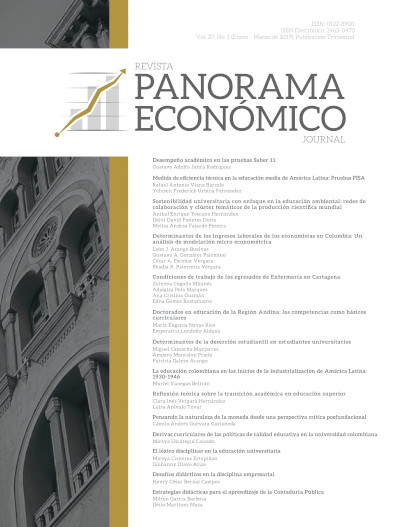Pensando la naturaleza de la moneda desde una perspectiva crítica posfundacional.
Thinking about the nature of currency from a post-foundation critical perspective.
Contenido principal del artículo
Resumen
El artículo busca rescatar y reformular una forma de pensar problemas epistemológicos en economía, específicamente en torno al debate de la naturaleza del dinero. Se presentan las dos concepciones antagónicas sobre la naturaleza del dinero; la del dinero-mercancía y la del dinero-deuda. Después se presenta la propuesta ontológica de Tony Lawson que articula las dos concepciones: el dinero no es en sí mismo mercancía o deuda, sino que estas formas son posicionamientos sociales del dinero. Se recogen algunas críticas a esta propuesta. Por último, dentro del espíritu de corrientes como la fenomenología y el pragmatismo, se propone un antiesencialismo crítico. Se argumenta a favor del dinero como relación social, por los mundos que se abren y las consecuencias que se producen.
Palabras clave:
Descargas
Detalles del artículo
Referencias (VER)
Aglietta, M., & Orleán, A. (1988). La violencia de la moneda. Mexico: Siglo XXI.
Aglietta, M., Ponsot, J.-F., & Ould Ahmed, P. (2016). Monnaie entre dettes et souveraineté. Paris: Éditions Odile Jacob.
Baskhar, R. (1975). A realist theory of science. New York: Routledge.
Colander, D. (2000). The death of neoclassical economics. Journal of the History of Economic Thought Volume 22, Issue 2, 127-143.
https://doi.org/10.1080/10427710050025330
Davidson, P. (1972). Money and the real world. London: Palgrave. https://doi.org/10.2307/2230209
Davidson, P. (2007). Money And Keynes. En P. Arestis, & M. Sawyer, A hanbook of alternative monetary economics (págs. 139-152). Chentelham: Edward Elgar.
Dequech, D. (2013). Is money a convention and/or a creature of the state? the convention of the acceptability, the state, contracts and taxes. Journal of Post Keynesians Economics, Vol 36 No2. 251251-275. https://doi.org/10.2753/PKE0160-3477360204
Dodd, N. (2014). The social life of money. New Jersey: Princeton Press. https://doi.org/10.1515/9781400852048
Dupuy, J.-P. (2012). L'Avenir de l'économie: Sortir de l'écomystification. Paris: Flammarion.
Escobar-Espinoza, A., & Angulo-Pico, G. (2015). Panorama Economico in the context of the international visibility of scientific journals. Panorama Económico, 23, 11-13. https://doi.org/10.32997/2463-0470-vol.23-num.1-2015-1733
Escobar-Espinoza, A., Guevara-Castañeda, D., & Uribe-Veloza, M. (2017). Modelos Computacionales y Análisis de la Política Económica en Colombia. Panorama Económico, 25(4), 535-558. https://doi.org/10.32997/2463-0470-vol.25-num.4-2017-2088
Felipe, J. (2009). Inclusive Growth, Full Employment, and Structural Change: Implications and Policies for Developing Asia. Cambridge: Anthem Press. https://doi.org/10.7135/UPO9781843313557
Feyerabend, P. (1978). La ciencia en una sociedad libre. México: Siglo XXI.
Fontana, G. (2004). Hicks on monetary theory and history: Money as endogenous money. Cambridge journal of economics, 28, 73-88.
https://doi.org/10.1093/cje/28.1.73
Girard, R. (1982). La violencia y lo sagrado. Barcelona: Anagrama.
Goodhart, C. (1998). The two concepts of money: implications for the analysis of optimal currency areas. european journal of political economy. Vol 14, 407-432. https://doi.org/10.1016/S0176-2680(98)00015-9
Graeber, D. (2011). Debt: The First 5,000 Years. New York: Melville House Publishing.
Hahn, F. (1965). On some problems of proving the existence of an equilibrium in a monetary economy. En F. Hahn , & F. Brechling, The Theory Of interest Rates (págs. 126-135).Macmillan.
Heidegger, M. (2005). Que significa pensar? Madrid: Trotta.
Ingham, G. (2004). Nature Of Money. London: Routledge.
Ingham, G. (2017). A critique of Lawson's 'Social positioning and the nature of money. Cambridge Journal of Economics 2017, 1-14.
Jevons, S. (1875). Money and the mechanism of exchange. New York: Cosimo Classics.
Jullien, F. (2008). Un sabio no tiene ideas. Madrid: Siruela.
Kalecki, M. (1943). Aspectos políticos del pleno empleo. Political Quarterly, vol 14, 347-356. https://doi.org/10.1111/j.1467-923X.1943.tb01016.x
Keen, S. (2011). Debunking economics. Madrid: Cápitan Swing. https://doi.org/10.5040/9781350250963
Lapavitsas, C. (2003). Social Foundations of Markets, Money and Credit. London: Routledge. https://doi.org/10.4324/9780203496701
Lavoie, M. (2014). Post-keynesian economics. London: Edward Elgar. https://doi.org/10.4337/9781783475827
Lawson, T. (1997). Economics and reality. Abingdon: Routledge. https://doi.org/10.4324/9780203195390
Lawson, T. (2016). Social positioning and the nature of money. Cambridge Journal of economics, 40, 961-996. https://doi.org/10.1093/cje/bew006
Marchart, O. (2009). El pensamiento político posfundacionalista. Bogotá: Fondo de cultura económica.
Martin, F. (2013). Money. The Unauthorised Biography. London: Vintage Books.
Marx, K. (1990). Tesis Sobre Feuerbach. Madrid: Grijalbo.
Maturana, H., & Varela, F. (1999). El arbol del conocimiento. Santiago de Chile: Lumen.
Menger, C. (1892). On the Origin of Money. The Economic Journal, 239-255. https://doi.org/10.2307/2956146
Mirowski, P., & Nik-Khah, E. (2017). The knowledge we have lost with information. New York: Oxford University Press. https://doi.org/10.1093/acprof:oso/9780190270056.001.0001
Moreno, A. (2014). Política monetaria y distribución funcional del ingreso. Documento escuela de economía No. 50, 1-39.
Orléan, A. (2011). L'Empire de la valeur. Refonder l'économie. París: Seuil.
Parguez, A., & Seccareccia, M. (1999). Credit theory: monetary circuit approach. En J. Smithin, What is money? (págs. 101-123). New York: Routledge. https://doi.org/10.4324/9780203072691.ch5
Pettifor, A. (2017). The production of money: How to break the power of banks. New York: Verso. Rochon, L.-P. (2017). Rethinking monetary policy. En L.-P. Rochon, & S. Rossi, A modern guide for rethinking economics (págs. 120-130). London: Edward Elgar.
Sala-i-Martin, X. (2015). Economía en colores. Barcelona: Conecta.
Schumpeter, J. (1988). Historia del analisis económico. Madrid: Ariel.
Searle, J. (2010). Creando el mundo social. La estructura de la civilización humana. Madrid: Paidos.
Simmel, G. (2014). Filosofía del dinero. Madrid: Capitán swing.
Smithin, J. (2013). Requirements of a Philosophy of Money And Finance. En J. Pixley et al., Financial Crises and the Nature of Capitalist Money (págs. 19-31). London: Palgrave Macmillan. https://doi.org/10.1057/9781137302953_2
Tsilipakos, L. (2012). The Poverty of Ontological Reasoning. Journal for the Theory of Social Behaviour, 1-19. https://doi.org/10.1111/j.1468-5914.2012.00486.x
Vergnhanini, R., & De Conti, B. (2017). Modern Monetary Theory: a criticism from the periphery. Brazilian keynesian review.
https://doi.org/10.33834/bkr.v3i2.115
Vergara-De la Ossa, R., Londoño-Vega, C., Pérez-Benítez, N., & Torres-Castellar, R. (2015). La adopción de las Normas Internacionales de Información Financiera en Colombia. Panorama Económico, 23, 119-132. https://doi.org/10.32997/2463-0470-vol.23-num.1-2015-1382
Weber, M. (2006). Economía y sociedad. México: Fondo de cultura económica.
Williamson, O. (1975). Markets and Hierarchies: Analysis and Antitrust. New York: Free Press.
Zelizer, V. (2011). El significado social del dinero. Buenos Aires: FCE.
Zelmanovitz, L. (2016). The ontology and function of money. The philosophical fundamentals of monetary institutions. Lanham: Lexington books.



 PDF
PDF
 FLIP
FLIP

